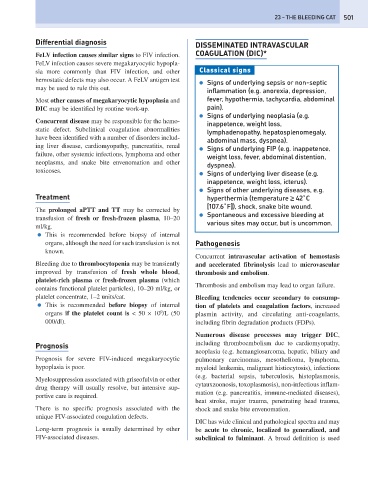Page 509 - Problem-Based Feline Medicine
P. 509
23 – THE BLEEDING CAT 501
Differential diagnosis DISSEMINATED INTRAVASCULAR
FeLV infection causes similar signs to FIV infection. COAGULATION (DIC)*
FeLV infection causes severe megakaryocytic hypopla-
sia more commonly than FIV infection, and other Classical signs
hemostatic defects may also occur. A FeLV antigen test
● Signs of underlying sepsis or non-septic
may be used to rule this out.
inflammation (e.g. anorexia, depression,
Most other causes of megakaryocytic hypoplasia and fever, hypothermia, tachycardia, abdominal
DIC may be identified by routine work-up. pain).
● Signs of underlying neoplasia (e.g.
Concurrent disease may be responsible for the hemo-
inappetence, weight loss,
static defect. Subclinical coagulation abnormalities
lymphadenopathy, hepatosplenomegaly,
have been identified with a number of disorders includ-
abdominal mass, dyspnea).
ing liver disease, cardiomyopathy, pancreatitis, renal
● Signs of underlying FIP (e.g. inappetence,
failure, other systemic infections, lymphoma and other
weight loss, fever, abdominal distention,
neoplasms, and snake bite envenomation and other
dyspnea).
toxicoses.
● Signs of underlying liver disease (e.g.
inappetence, weight loss, icterus).
● Signs of other underlying diseases, e.g.
Treatment hyperthermia (temperature ≥ 42˚C
[107.6˚F]), shock, snake bite wound.
The prolonged aPTT and TT may be corrected by
● Spontaneous and excessive bleeding at
transfusion of fresh or fresh-frozen plasma, 10–20
various sites may occur, but is uncommon.
ml/kg.
● This is recommended before biopsy of internal
organs, although the need for such transfusion is not Pathogenesis
known.
Concurrent intravascular activation of hemostasis
Bleeding due to thrombocytopenia may be transiently and accelerated fibrinolysis lead to microvascular
improved by transfusion of fresh whole blood, thrombosis and embolism.
platelet-rich plasma or fresh-frozen plasma (which
Thrombosis and embolism may lead to organ failure.
contains functional platelet particles), 10–20 ml/kg, or
platelet concentrate, 1–2 units/cat. Bleeding tendencies occur secondary to consump-
● This is recommended before biopsy of internal tion of platelets and coagulation factors, increased
9
organs if the platelet count is < 50 × 10 /L (50 plasmin activity, and circulating anti-coagulants,
000/dl). including fibrin degradation products (FDPs).
Numerous disease processes may trigger DIC,
Prognosis including thromboembolism due to cardiomyopathy,
neoplasia (e.g. hemangiosarcoma, hepatic, biliary and
Prognosis for severe FIV-induced megakaryocytic pulmonary carcinomas, mesothelioma, lymphoma,
hypoplasia is poor. myeloid leukemia, malignant histiocytosis), infections
(e.g. bacterial sepsis, tuberculosis, histoplasmosis,
Myelosuppression associated with griseofulvin or other
cytauxzoonosis, toxoplasmosis), non-infectious inflam-
drug therapy will usually resolve, but intensive sup-
mation (e.g. pancreatitis, immune-mediated diseases),
portive care is required.
heat stroke, major trauma, penetrating head trauma,
There is no specific prognosis associated with the shock and snake bite envenomation.
unique FIV-associated coagulation defects.
DIC has wide clinical and pathological spectra and may
Long-term prognosis is usually determined by other be acute to chronic, localized to generalized, and
FIV-associated diseases. subclinical to fulminant. A broad definition is used

